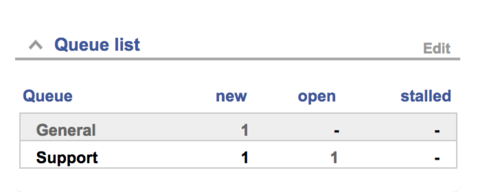ManualSearchTickets: Difference between revisions
mNo edit summary |
mNo edit summary |
||
| Line 9: | Line 9: | ||
Searches can be saved, shared between groups, placed on the home page, bookmarked in the browser, used in charts or even emailed within [[ManualDashboards|Dashboards]]. | Searches can be saved, shared between groups, placed on the home page, bookmarked in the browser, used in charts or even emailed within [[ManualDashboards|Dashboards]]. | ||
= Queue | = Queue List = | ||
[[File:Queue-List.png|Queue List portlet|thumb|500px]] | [[File:Queue-List.png|Queue List portlet|thumb|500px]] | ||
Revision as of 10:56, 20 March 2019
Introduction
RT comes with several interfaces to search for tickets: queue list, simple search, and the query builder search.
Searches can be saved, shared between groups, placed on the home page, bookmarked in the browser, used in charts or even emailed within Dashboards.
Queue List

The Queue List is a portlet that you can see on the home page, by default. This is a table where rows are queues you can see and columns are active statuses, each cell of the table shows number of tickets.
Queue name and each number in this table is clickable, so you can jump to a page with search results.
Simple search
Simple search is an input box in the upper right of all pages, there is "Search" button next to the box. There is "Simple Search" button in the menu, as well, that leads to the simple search page with some hints.
This search allows you to use some magic, for example you can type in a ticket number, and jump directly to that ticket. Check out ManualSimpleSearch.
Advanced search
NOTE This information is heavily based on RT 3.0 where query builder was different than in newer versions.
More advanced ticket search is available by clicking Tickets in the menu. This is a query builder with many fields listed for you to build your searches.
It is fairly intuitive, but there are some features worth noting:
- Searches, by default, are sticky. That is, if you return to the Search page during a session, it will display the most recent search (unless you click on the "new query" link).
- Searches are, by default, limited. You can walk by pages or unlimit them.
- Searches are iterative - you build them up. If you search for tickets owned by Jane, then search for open tickets, you'll get open tickets owned by Jane.
- When RT displays a ticket that is part of the current search, it will also display Previous, Next, First, and Last links for navigating through the matching tickets.
If you get too many results, you can still pinpoint what you need by searching again to narrow the results down.
You can search by owner, requestor email address, ticket subject, queue, priority, attachment, and/or status. For instance, you could search for tickets you own by selecting your own name from the Owner drop-down menu, or search for only high priority tickets.
Relative Date Searching
Consider needing a bookmarkable search which lists what you've resolved in the last month or what is due in the next week. Manually entered dates make the search outdated soon after creation. The perl module that RT uses allows for some relative date/time phrases.
NOTE: See the Time::ParseDate man page for more options
Examples:
Tickets resolved in the last month
Resolved -> After -> -1 month
Tickets created in the last week
Created -> After -> -1 week
Tickets due in the next week
Due -> After -> Today AND Due -> Before -> +1 week
Tickets created between an hour and three hours ago
Created -> After -> -1 hour AND Created -> After -> -3 hour
Advanced Search vs. other searches
Most interfaces that simplify search, like quick and simple searches, at the end generate a query using special syntax and redirect you to results page that is part of advanced search. So you can click 'Edit Search' in the UI and refine it with more conditions.
Search results
Search results looks like on the following screenshot. It's screenshot from old version.
Changing display format
You may also alter the number of search results returned per page, how the results are sorted, and how often the page is refreshed. Click the Search button when you're done.
To bookmark a search so you can return to the results later:
- click Bookmarkable URL for this search
- add the page to your Bookmarks, Favorites, or whatever applies for your browser
To clear previous search results and start a new search:
- click New Search in the left side navigation bar
Saving Searches
After you've added all of the criteria you want for a query, before clicking search, first select where you'd like to save this search (the "Privacy" pulldown). You can save for only yourself "My Saved Searches", or for a group you are a member of "Group A's saved searches". Type in the description, then click save. Later, you can load the query from the "Load saved search" pulldown. You must have the correct permissions to show saved searches and to edit them.